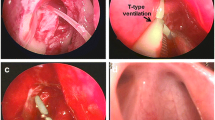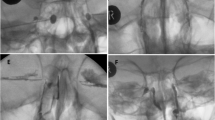Abstract
Purpose
This article is to introduce office-based salvage revision of impending rhinostomy failure after endoscopic dacryocystorhinostomy (EN-DCR), using a microdebrider.
Methods
The authors conducted retrospective medical chart review of 27 eyes of 26 patients who underwent microdebrider treatment for impending rhinostomy failure in an office setting. After local anesthesia, obstructive soft tissue, interfering with ostium function (granuloma, cicatrization, synechia), was treated with a microdebrider (Osseoduo s120, Bien-Air Surgery, Le Noirmont, Switzerland) within 6 months after primary EN-DCR. Anatomical improvement and functional relief of epiphora were evaluated after revision.
Results
The causes of impending rhinostomy failure were granuloma formation (17/27 eyes, 63.0%), cicatrization (8/27 eyes, 29.6%), and synechial formation (2/27 eyes, 7.4%). The surgery did not exceed 5 min in all cases, and partial damage to pre-placed silicone tubes occurred in the first two cases (7.4%). Salvage revision resulted in anatomical success in all eyes, based on patent syringing and a positive functional endoscopic dye test. All cases showed improvement of epiphora after revision surgery.
Conclusions
Office-based salvage revision using a microdebrider provided effective management of impending rhinostomy failure during early follow-up period after primary EN-DCR. It enabled prompt management of excessive wound healing interfering with ostium function, while performing the routine postoperative nasal debridement.


Similar content being viewed by others

References
Woog JJ, Kennedy RH, Custer PL, Kaltreider SA, Meyer DR, Camara JG (2001) Endonasal dacryocystorhinostomy: a report by the American Academy of Ophthalmology. Ophthalmology 108:2369–2377
Ben Simon GJ, Joseph J, Lee S, Schwarcz RM, McCann JD, Goldberg RA (2005) External versus endoscopic dacryocystorhinostomy for acquired nasolacrimal duct obstruction in a tertiary referral center. Ophthalmology 112:1463–1468
Hartikainen J, Grenman R, Puukka P, Seppa H (1998) Prospective randomized comparison of external dacryocystorhinostomy and endonasal laser dacryocystorhinostomy. Ophthalmology 105:1106–1113
Tsirbas A, Wormald PJ (2003) Mechanical endonasal dacryocystorhinostomy with mucosal flaps. Br J Ophthalmol 87:43–47
McLachlan DL, Shannon GM, Flanagan JC (1980) Results of dacryocystorhinostomy: analysis of the reoperations. Ophthalmic Surg 11:427–430
Walland MJ, Rose GE (1994) The effect of silicone intubation on failure and infection rates after dacryocystorhinostomy. Ophthalmic Surg 25:597–600
Allen KM, Berlin AJ, Levine HL (1988) Intranasal endoscopic analysis of dacrocystorhinostomy failure. Ophthal Plast Reconstr Surg 4:143–145
Welham RA, Wulc AE (1987) Management of unsuccessful lacrimal surgery. Br J Ophthalmol 71:152–157
Ali MJ, Psaltis AJ, Wormald PJ (2014) Dacryocystorhinostomy ostium: parameters to evaluate and DCR ostium scoring. Clin Ophthalmol 8:2491–2499
Sahlin S, Chen E (1996) Evaluation of the lacrimal drainage function by the drop test. Am J Ophthalmol 122:701–708
Tsirbas A, Davis G, Wormald PJ (2005) Revision dacryocystorhinostomy: a comparison of endoscopic and external techniques. Am J Rhinol 19:322–325
Metson R (1990) The endoscopic approach for revision dacryocystorhinostomy. Laryngoscope 100:1344–1347
Lee J, Choi SY, Lee H, Chang M, Park M, Baek S (2015) The clinical effectiveness of transcanalicular diode laser-assisted revision surgery for failed endoscopic endonasal dacryocystorhinostomy. Br J Ophthalmol 99:1130–1133
Hull S, Lalchan SA, Olver JM (2013) Success rates in powered endonasal revision surgery for failed dacryocystorhinostomy in a tertiary referral center. Ophthal Plast Reconstr Surg 29:267–271
Ragab SM, Elsherif HS, Shehata EM, Younes A, Gamea AM (2012) Mitomycin C-enhanced revision endoscopic dacryocystorhinostomy: a prospective randomized controlled trial. Otolaryngol Head Neck Surg 147:937–942
Woog JJ, Metson R, Puliafito CA (1993) Holmium:YAG endonasal laser dacryocystorhinostomy. Am J Ophthalmol 116:1–10
Kong YT, Kim TI, Kong BW (1994) A report of 131 cases of endoscopic laser lacrimal surgery. Ophthalmology 101:1793–1800
Park J, Kim H (2016) Office-based endoscopic revision using a microdebrider for failed endoscopic dacryocystorhinostomy. Eur Arch Otorhinolaryngol 273:4329–4334
Freitag SK, Yoon MK, Callahan AB, Lee NG, Lefebvre DR (2014) Microdebrider use in orbital surgery. Orbit 33:189–192
Yoon SW, Yoon YS, Lee SH (2006) Clinical results of endoscopic dacryocystorhinostomy using a microdebrider. Korean J Ophthalmol 20:1–6
Nguyen J, Fay A, Yadav P, MacIntosh PW, Metson R (2014) Stereotactic microdebrider in deep lateral orbital decompression for patients with thyroid eye disease. Ophthal Plast Reconstr Surg 30:262–266
Thacker NM, Velez FG, Demer JL, Wang MB, Rosenbaum AL (2005) Extraocular muscle damage associated with endoscopic sinus surgery: an ophthalmology perspective. Am J Rhinol 19:400–405
Howell RJ, Solowski NL, Belafsky PC, Courey MC, Merati AL, Rosen CA, Weinberger PM, Postma GN (2014) Microdebrider complications in laryngologic and airway surgery. Laryngoscope 124:2579–2582
Hilton GF, Josephberg RG, Halperin LS, Madreperla SA, Brinton DA, Lee SS, Gordon SF (2002) Office-based sutureless transconjunctival pars plana vitrectomy. Retina 22:725–732
Author information
Authors and Affiliations
Contributions
Conception and design: J.P. and H.K; conduct the study: S.K., C.H.K, and J.P.; collection, management, and interpretation of data: S.K., C.H.K., J.P., and H.K.; data analysis: S.K. and C.H.K.; wrote the article: S.K. and J.P.; and preparation, review, and approval of the manuscript: J.P. and H.K.
S.K. and C.H.K contributed equally to the manuscript as the co-first author.
J.P and H.K contributed equally to the manuscript as the co-corresponding authors.
All authors reviewed the manuscript and approved the final version
Corresponding authors
Ethics declarations
Ethical approval
All procedures performed in studies involving human participants were in accordance with the ethical standards of the institutional research committee and with the Helsinki Declaration and its later amendments or comparable ethical standards.
Informed consent
Informed consent was obtained from all individual participants included in the study.
Conflict of interest
The authors declare no competing interests.
Additional information
Publisher's note
Springer Nature remains neutral with regard to jurisdictional claims in published maps and institutional affiliations.
Suhwan Kim and Chang Hoi Kim contributed equally to this work as co-first authors.
Jongyeop Park and Hochang Kim contributed equally to this work as co-corresponding authors.
Rights and permissions
About this article
Cite this article
Kim, S., Kim, C.H., Park, J. et al. Salvage of impending rhinostomy failure after dacryocystorhinostomy with office-based microdebrider treatment. Graefes Arch Clin Exp Ophthalmol 260, 1315–1321 (2022). https://doi.org/10.1007/s00417-021-05421-8
Received:
Revised:
Accepted:
Published:
Issue Date:
DOI: https://doi.org/10.1007/s00417-021-05421-8



